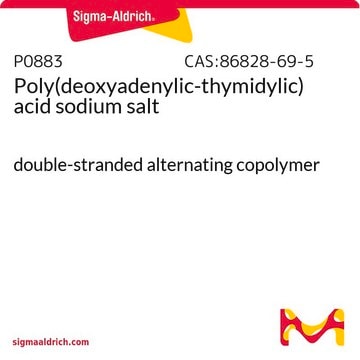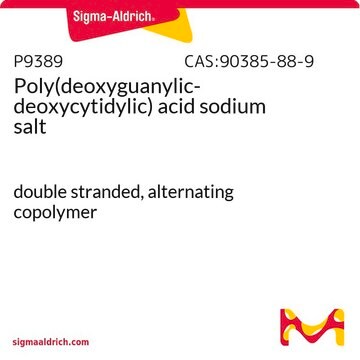P1038
Poly(cytidylic-inosinic) acid potassium salt
random copolymer
Synonym(e):
Poly (C,I)
Anmeldenzur Ansicht organisationsspezifischer und vertraglich vereinbarter Preise
Alle Fotos(2)
About This Item
Empfohlene Produkte
Anwendung
Poly(cytidylic-inosinic) acid potassium salt has been used:
- in pretreatment to understand Con A-induced hepatitis in mice
- in RNA extraction from hemolymph plasma for qPCR detection assay
- to induce inflammatory changes in liver
- as a component of minimal essential medium for the stimulation of rainbow trout gonad line RTG-2 cells
Biochem./physiol. Wirkung
Poly(cytidylic-inosinic) Poly(C,I) is a random copolymer of inosine and cytidine bases which may be useful for comparative physicochemical analysis versus other random copolymers such as Poly(C,A), Poly(C,U) and Poly(C,G).
Poly(cytidylic-inosinic) acid, poly I:C mimics viral RNA to induce immune response. Administration of poly I:C promotes cytotoxic functionality of natural killer cells and macrophages. However, poly I:C may trigger generation of anti-mitochondrial antibodies (AMAs) and contribute to the pathogenesis of primary biliary cirrhosis (PBC). Poly I:C may play a hepatoprotective role in Con A-induced T cell-dependent liver injury.
Sonstige Hinweise
Random copolymer
Lagerklassenschlüssel
11 - Combustible Solids
WGK
WGK 3
Flammpunkt (°F)
Not applicable
Flammpunkt (°C)
Not applicable
Persönliche Schutzausrüstung
Eyeshields, Gloves, type N95 (US)
Analysenzertifikate (COA)
Suchen Sie nach Analysenzertifikate (COA), indem Sie die Lot-/Chargennummer des Produkts eingeben. Lot- und Chargennummern sind auf dem Produktetikett hinter den Wörtern ‘Lot’ oder ‘Batch’ (Lot oder Charge) zu finden.
Besitzen Sie dieses Produkt bereits?
In der Dokumentenbibliothek finden Sie die Dokumentation zu den Produkten, die Sie kürzlich erworben haben.
Kunden haben sich ebenfalls angesehen
G F Joyce et al.
Journal of molecular biology, 188(3), 433-441 (1986-04-05)
Poly(C, G) random copolymer templates direct the oligomerization of 2-Me-ImpG and 2-MeImpC, resulting in the production of a variety of oligo(G, C)s. The efficiency of monomer incorporation into newly synthesized oligomers is greater for 2-MeImpG than for 2-MeImpC, and decreases
Persistence of double-stranded RNA in insect hemolymph as a potential determiner of RNA interference success: evidence from Manduca sexta and Blattella germanica
Garbutt JS, et al.
Journal of Insect Physiology, 59(2), 171-178 (2013)
G F Joyce et al.
Journal of molecular biology, 176(2), 279-306 (1984-06-25)
Poly(C, U) random copolymer templates direct the oligomerization of 2-MeImpG and 2-MeImpA, resulting in the production of a variety of oligo/(G,A)s. The efficiency of monomer incorporation into newly synthesized oligomers is greater for 2-MeImpG than for 2-MeImpA, and decreases for
G F Joyce et al.
Journal of molecular biology, 202(3), 677-681 (1988-08-05)
Poly(C,A) random copolymer templates direct the oligomerization of 2-MeImpG (2-MeImpX is the 5'-phospho-2-methylimidazolide of the nucleoside X) and 2-MeImpU, resulting in the production of a variety of oligo (G,U)s. This reaction is less efficient than comparable reactions involving poly(C,U) or
The multi-hit hypothesis of primary biliary cirrhosis: polyinosinic-polycytidylic acid (poly I: C) and murine autoimmune cholangitis
Wang J, et al.
Journal of Hepatology, 44(3), 446-454 (2006)
Unser Team von Wissenschaftlern verfügt über Erfahrung in allen Forschungsbereichen einschließlich Life Science, Materialwissenschaften, chemischer Synthese, Chromatographie, Analytik und vielen mehr..
Setzen Sie sich mit dem technischen Dienst in Verbindung.












